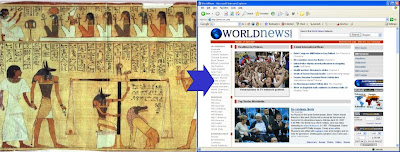To all corners of the earth
Long before Europeans developed an ocean-going capability, humans had reached the furthest corners of the earth. This included not only every continent but even the remote Easter Island, thousands of miles from habitation in every direction. Some other Pacific islands, such as Christmas Island, showed signs of human settlements that had died out before Europeans first arrived.
This tells us something about people. Humanity, like nature, abhors a vacuum. Humans do not naturally stick together and congregate in large numbers. There is rather a continual outward pressure as people try to get away from each other.
The stone age lifestyle, based on hunting and gathering, requires a large amount of land area per person. If human numbers were going to grow, people had the choice of staying where they were and developing more advanced food production technologies (to support more people from the same land area) or move steadily out into virgin territory. In reality, people did not make a conscious choice. Moving to new territory would have seemed like the only option, and it was only when the world had filled up that humans had to confront and solve the problem of feeding more people from the same area of land.
The hunting-gathering lifestyle naturally draws people on. Rather than moving a little each day, hunter-gatherers tend to stay in one place for a while and then relocate in one big jump. It has been said they eat their way out of camp. The longer they stay, the further they have to travel to find new food sources. In a matter of weeks, the daily round trip exceeds twenty or thirty miles, and it becomes necessary to make a major move.
This outward pressure can take people a long way in a short time. It often seems to be assumed that for early humans to migrate, say, a thousand miles would have taken many generations. Yet even in the stone age, people could in principle have travelled from one end of the earth to the other in their own lifetimes. Consider that the circumference of the earth is roughly 25,000 miles. For a stone age person with an active life of 25 years, it would be necessary to travel 1000 miles per year, or under 3 miles per day, to cover this distance. People who follow stone-age lifestyles today can easily do that kind of mileage.
Of course, humans would not have gone directly around the equator, with several oceans in the way. Nor would they have walked directly across the continents, where the way can be barred by mountains and deserts.
Their easiest route would have been along the coastline. Since people reached Australia very early, they may have had simple boats from the very beginning, as they came out of Africa. This would have sped them on their way.
At the beginning of the upper paleolithic, 40,000 years ago, sea level was lower than it is today. This left a continuous land route from Africa to the Americas, with no ice barriers. Here is a map of the world at that time:
The above image was created using a program at the site of Sebastien Merkel. This allows you to enter a given sea level and view the resulting map. Information about how sea level has changed over time is available at this site.
With sea level as above, travel to Australia still required crossing open water. However, this could be done by island-hopping, with each island visible from the previous one. Only the final crossing, of about 100 miles, required a leap into the unknown, but Australia was a large target and people could have spotted it during short sea trips to and from their home base. (Humans could also have arrived at Australia via New Guinea, which was then connected to Australia by land. However, it is believed they did not take that route and New Guinea was settled after Australia.)
I do not accept that humans only gradually diffused through the world. I believe that, following initial speciation in Africa, humans exploded across the planet, so that the world was occupied almost simultaneously at around 40,000 years ago.
We can estimate how long it would have taken people to spread to fill every continent.
Modern hunter-gatherers live at densities of around 1 person per 15 square miles (compared with 67,000 persons per square mile in Manhattan). However, they tend to occupy marginal environments, the best land having been taken over long ago by agriculturalists. Average population densities in the old stone age might have been higher, perhaps as high as 1 person per square mile. Since the habitable area of the world is about 15 million square miles, the total human population of the world, with paleolithic technology, would have been somewhere between 1 million and 15 million.
Let us define the following:
| A = | total area of the world habitable by hunting and gathering (say, 15 million square miles) |
| ρ = | population density of hunter-gatherers (say, 1 person per square mile) |
| T = | time for an unconstrained human population to double in numbers (say, 10 years, which was observed on Pitcairn Island during the first thirty years after it was settled by the Bounty mutineers) |
| t = | time |
The number of hunter-gatherers that would saturate the world is A ρ, while, starting from a population of 1 (a pregnant woman), the number of humans after time, t, would be 2t/T.
The time taken to populate the world is therefore given by
A ρ = 2t/T
or
t = T log2(A ρ)
Putting in the numbers suggested above, this comes to about 240 years, for humans to cover the planet.
Of course, this figure should not be taken literally. It is just to give us a feel for the issue. A larger starting population (1 pregnant woman is a little unrealistic) would reduce the time, as would a lower population density, while a longer doubling time would increase it. The point is that humanity's spread through the world does not need to have taken a hugely long time, and in fact it is unlikely that it took a hugely long time.
Note that, once the world was fully populated, population growth would have had to stop until technological improvements allowed more people to be supported from the same land surface. Modern hunter-gatherers are adept at keeping their numbers in tune with their environment, or in fact in tune with what the environment can support in its leanest years. There would therefore have been a short population explosion, followed by near-stagnation (until the development of farming).
Three factors would have slowed down human expansion relative to this simple picture:
- Obstructions, such as deserts, mountains and waterways. Crossing the Amazon at its mouth, for example, is like crossing the English channel.
- Varying ecological conditions. People who knew how to exploit the flora and fauna of one environment (grassland, forest, seashore) would have had to learn new skills to survive in a different one.
- Presence of other hominids. Neanderthals and other hominids already occupied the lands outside Africa. Modern humans would have been competing with them for resources, and might for some time have been kept out of their territories by fear or force.
Nevertheless, people could still have reached every continent in a short time, even if actually filling the continents was slower than the simple argument suggests. Having boats and following the coastline, humans would have remained within a familiar environment while being able to bypass obstacles. As for conflict with other hominids, it might even have been a factor drawing the more capable humans onwards.


















